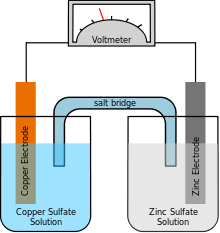Lithium–titanate battery
The lithium–titanate battery is a type of rechargeable battery, which has the advantage of being faster to charge than other lithium-ion batteries. Titanate batteries are used in Mitsubishi's i-MiEV[1] electric vehicle and Honda uses them in its EV-neo electric bike and Fit EV.[2][3] Opportunity charging in public transportation, such as large capacity electric bus project TOSA, is using the Titanate batteries high charging capability to partly recharge the battery in 15 seconds while passengers are disembarking and embarking at bus stops[4]
A lithium–titanate battery is a modified lithium-ion battery that uses lithium-titanate nanocrystals on the surface of its anode instead of carbon. This gives the anode a surface area of about 100 square meters per gram, compared with 3 square meters per gram for carbon, allowing electrons to enter and leave the anode quickly. This makes fast recharging possible and provides high currents when needed.[5]
A disadvantage of lithium-titanate batteries is that they have a lower inherent voltage (2.4 V), which leads to a lower specific energy of about 30-110Wh/kg[6] than conventional lithium-ion battery technologies (which have an inherent voltage of 3.7 V).[7]
Lithium-titanate batteries are reported to have a volumetric energy density of up to 177 Wh/L.[6]
Brands and uses
Altairnano
Altairnano produce lithium–titanate batteries under the "Nanosafe" line, mainly for battery electric vehicles. Some vehicle manufacturers which announced plans to use Altairnano batteries includes Lightning Car Company, which plan to use them for Lightning GT, an all-electric sports car,[8][9] Phoenix Motorcars, in its electric sport-utility vehicles,[10] and Proterra, in its all-electric EcoRide BE35 vehicle, a lightweight 35-foot bus.[11]
Altairnano has also deployed their lithium–titanate energy storage systems for electric grid ancillary services[12] and in various military applications.[13]
Leclanché
Leclanché is a Swiss battery manufacturer, founded in 1909. In 2006 acquisition of Bullith AG (Germany) to establish a Li-Ion manufacturing line in Germany. In 2014 the "TiBox" was launched in the market. The power content of the "TiBox" is 3.2kWh with 20'000 cycles.
Toshiba

Toshiba released a lithium–titanate battery, dubbed Super Charge Ion Battery (SCiB).[14][15] The battery is designed to offer 90% charge capacity in just 10 minutes.[16]
SCiB batteries are used in the Schwinn Tailwind electric bike.[17] Toshiba has also demonstrated its use as a prototype laptop battery.[18] Toshiba SCiB batteries are also used in Mitsubishi's i-MiEV and Minicab MiEV[1] electric vehicles, and Honda uses them in its EV-neo electric bike and Fit EV model which launched in the summer of 2012.[2][3]
Seiko
Seiko uses lithium titanate batteries in its recent Kinetic (automatic quartz) wristwatches. Earlier Kinetic watches used a capacitor to store energy but the battery gives larger capacity and longer service life. It can be replaced easily by a technician when its capacity eventually deteriorates to an unacceptable level.
YABO
YABO Power Technology released lithium titanate battery in 2012. The standard model YB-LITE2344 2.4V/15Ah battery cell has been used in electric vehicle and energy storage systems.
See also
- List of battery types
- List of battery sizes
- Comparison of battery types
- Battery (electricity)
- Electrochemical cell
- Energy storage
- Fuel cell
- Lithium iron phosphate battery
References
- 1 2 "Mitsubishi Chooses Super-Efficient Toshiba SCiB Battery For EVs". Integrity Exports. 2011-06-18. Retrieved 2011-06-18.
- 1 2 "Toshiba's SCiB battery for the Fit EV". Green Car Congress. Nov 17, 2011.
- 1 2 "Honda begins European demonstration program of EV-neo electric scooter". Green Car Congress. Jun 15, 2011.
- ↑ TOSA2013: The project aims to introduce a new system of mass transport with electric “flash” recharging of the buses at selected stops.
- ↑ Graham-Rowe, Duncan (7 March 2005). "Charge a battery in just six minutes". NewScientist. Retrieved 2010-07-06.
- 1 2 "All About Batteries, Part 12: Lithium Titanate (LTO)". EETimes.
- ↑ "Green Car Congress: Toshiba Developing 3.0 Ah High Power SCiB Li-Ion Cell for HEV Applications". 21 May 2008. Retrieved 2010-07-07.
- ↑ Page, Lewis (2008-07-22). "Blighty's electro-supercar 2.0 uncloaked today". The Register. Retrieved 2008-07-22.
- ↑ "Welcome to Lightning Car Company". Archived from the original on May 26, 2010. Retrieved 2010-07-07.
- ↑ "The All-New Phoenix SUV". Phoenix Motorcars. Archived from the original on July 29, 2010. Retrieved 2010-07-07.
- ↑ "Proterra – Cost effective solutions for clean transportation". Proterraonline.com. Archived from the original on March 1, 2009. Retrieved 2010-07-06.
- ↑ "Altair Nanotechnologies Announces Successful PJM Market Acceptance of the First Grid-Scale, Battery Energy Storage System" (Press release). Altair Nanotechnologies. 2008-11-21. Retrieved 2010-07-06.
- ↑ "Altair Nanotechnologies Power Partner – The Military" (Press release). Altair Nanotechnologies. Retrieved 2010-07-06.
- ↑ Kouji Kariatsumari (Dec 12, 2007). "Toshiba's New Secondary Battery Squashed ... No Explosion, Fire ... Why?". Nikkei Electronics. Retrieved 2010-07-07.
- ↑ "TOSHIBA – Rechargeable battery SCiB". Retrieved 2010-07-07.
- ↑ Aharon Etengoff (Oct 2, 2008). "Toshiba unveils new battery prototype". PC Authority. Retrieved 2010-07-07.
- ↑ "Schwinn Electric Bikes". Schwinn Tailwind electric. Retrieved 2010-07-07.
- ↑ Sumner Lemo (September 30, 2008). "Toshiba shows prototype fast-charging laptop battery". InfoWorld. Retrieved 2010-07-07.
